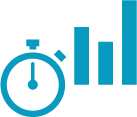Environmental Monitoring Savings:
A Closer Look
| Your estimated annual power and cooling costs |
|
|
| Typical annual power/cooling cost per rack for data centers your size x number of racks |
|
|
| (Source: Ponemon Institute, "Cost to Support Compute Capacity") |
|
|
| |
|
|
| Savings from increasing CRAC Set point from to |
|
|
| Estimated annual power/cooling costs x 2% |
|
|
| x 2% |
|
|
| |
|
|
| Cost of 1 year CenterScape subscription |
|
|
| number of racks x $ 300 |
|
|
| x $ 300 |
- |
|
| |
|
|
| Potential Environmental Monitoring Savings |
|
|
Data centers are expensive - to build and to run. With the costs of power and cooling growing at unprecedented rates, no organization can afford to let these multimillion dollar assets operate at anything less than optimal efficiency.
Data center operators and industry analysts have long agreed that for each 1 degree Fahrenheit increase in your data center set points you can reduce your annual data center power costs by 2-5%. But you can't just raise set points arbitrarily: raise data center temperatures too much, and you jeopardize your equipment and risk costly downtime. Accurate, real-time monitoring helps you balance these risks and rewards.
Calculating Your Savings:
To estimate your annual power/cooling costs we have used data from the Ponemon Institute's 2016 report "Cost to Support Compute Capacity," which found that a square foot data center with racks under management will spend approximately each year on energy. For the purposes of this calculator we are keeping savings estimates conservative, and estimating only a 2% savings for each degree Fahrenheit set points are increased.

Deploying RF Code's wire-free environmental monitoring solution would give you the granular monitoring you'd need to reduce your operational expenses by at least simply by safely increasing your data center set points 1 degree Fahrenheit, from ° to °. Depending on the cost of power in your area and other data center performance characteristics these savings could be as high as 5% per degree, with potential savings as high as .
And that's just the start. According to Erik Teetzel, Energy Program Manager at Google, "The guidance we give to data center operators is to raise the thermostat. Many data centers operate at 70 degrees or below. We'd recommend looking at going to 80 degrees." And American Society of Heating, Refrigerating and Air-Conditioning Engineers (ASHRAE) recommends an inlet temperature range of 68 to 77 degrees, and is looking at expanding that range (perhaps as high as 80 to 85 degrees) to reflect the stronger performance characteristics of modern data center equipment.

Clearly, set point increases of just a degree or two are just scratching the surface of the potential savings that are available. But these changes must be made carefully, and results must be measured and monitored continuously to ensure efficiency gains don't come at the expense of disastrous downtime. With RF Code's real-time, wire-free monitoring capabilities you gain environmental visibility down to the rack level. RF Code immediately alerts you to temperature and humidity changes, changes in air pressure, fluid leaks and more, ensuring you can:
- Get immediate, real-time data and warnings when problems are detected
- Prevent disasters and minimize downtime
- Correlate environmental and asset data for accurate density management
- Monitor temperature, humidity, fluid detection, air pressure, rack level power usage and more in real-time
Back
Next
Asset Management Savings:
A Closer Look
| Cost of replacing 20% of unaccounted for assets |
|
|
| [(number of racks x assets per rack) x average asset cost x percent unaccounted for x 20%] |
|
|
| [( x ) x x x 20%] |
|
|
| |
|
|
| Cost of labor associated with manual asset reconciliation processes |
|
|
| [number of racks x average assets per rack x percent unaccounted for x $100/hr, assuming 4 assets located per hour] |
|
|
| [ x x x $100/hr] / 4 |
+ |
|
| |
|
|
| Cost of 1 year CenterScape subscription |
|
|
| number of racks x $ 300 |
|
|
| x $ 300 |
- |
|
| |
|
|
| Potential Asset Management Savings |
|
|
Accurate, up-to-date and easily verifiable information is critical to effective data center operations. With real-time asset tracking and automation, you can manage the entire lifecycle of your assets -- from purchase through deployment to end-of-life -- to calculate and reduce the total cost of ownership of your data center.
With racks in your data center, averaging assets per rack, each of which is valued at an average , your data center contains in enterprise assets. With your typical audit resulting in of those assets being unaccounted for, this translates into assets with a total value of that are missing, lost, incorrectly deployed, or unaccounted for each annual audit cycle.
Calculating Your Savings:
When assets go missing, companies must attempt to locate the assets through an inventory reconciliation process. Unlike the initial audit (where inexpensive temporary labor is often used), reconciliations are typically carried out by data center staff because the reconciliation process requires more access to and knowledge of the facility. These professionals then must spend valuable time trying to find missing equipment ... instead of the running the data center.
And clearly, since the assets were not located during the initial audit they are not where they are supposed to be, making locating them a challenge. In smaller data centers reconciliation efforts can take just a few days, but in larger enterprises and distributed environments this "finding a needle in a haystack" process can easily stretch to weeks of difficult, time consuming and costly work - work that diverts them from the core tasks they must perform to ensure data center availability and efficiency -- following every single audit.

If we assume that it takes just 15 minutes to locate each missing asset that means it will take your staff person-hours to attempt to track down those missing assets ... instead of performing their "real" jobs. The hourly burden rate for data center personnel varies widely based on experience and location, but even assuming a fairly low $100/hour total burden rate that's operational expense wasted attempting to find missing assets. By continuously tracking the location of each and every asset in your data center throughout its entire lifecycle, RF Code eliminates costly reconciliation processes -- and the operational expenses associated with them - altogether, saving money and ensuring your data center personnel are using their expertise to perform the valuable tasks they're best utilized for.

Regardless of how thorough your reconciliation process is, some portion of your missing assets will almost certainly have to be written off and will need to be replaced. For the purposes of this savings calculator, we have estimated that you will need to purchase replacements for only 1 out of every 5 of your missing assets, though depending on what specific assets are missing, available inventory in storage for replacement purposes, and other factors it is entirely possible this percentage will be significantly higher. Even at a replacement rate of only 20%, RF Code's continuous asset tracking ensures complete visibility into asset location in real-time, ensuring that assets simply do not go missing in the first place and saving you approximately each year.

And the savings don't stop there. By eliminating the costs associated with manual data collection processes like bar code scanning and passive RFID solutions you eliminate the labor costs associated with data collection, data entry, and reconciliation, while also ensuring that strategic, business-critical decisions are made based on accurate, continuously updated information. RF Code's complete asset lifecycle management solution unites your commercial, business and operational data so you can track, trend and manage every asset in your IT estate effectively, providing:
- Accurate, real-time insight into asset inventories, including their location, current condition and financial impact
- Reduced costs by preventing over-provisioning and efficient capacity management
- Automated audits by eliminating time-consuming and expensive manual processes
- 100% utilization throughout an asset's entire lifecycle
- Clearer forecasting for density management, a smoother asset acquisition process and data-driven commercial planning
 View Case Study
View Case Study View Case Study
View Case Study View Case Study
View Case Study View Case Study
View Case Study View Case Study
View Case Study View Case Study
View Case Study